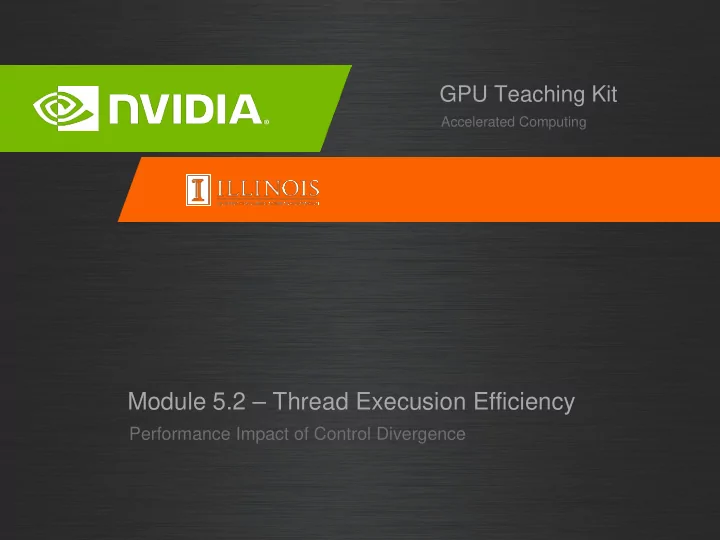

GPU Teaching Kit Accelerated Computing Module 5.2 – Thread Execusion Efficiency Performance Impact of Control Divergence
Objective – To learn to analyze the performance impact of control divergence – Boundary condition checking – Control divergence is data-dependent 2
Performance Impact of Control Divergence – Boundary condition checks are vital for complete functionality and robustness of parallel code – The tiled matrix multiplication kernel has many boundary condition checks – The concern is that these checks may cause significant performance degradation – For example, see the tile loading code below: if(Row < Width && t * TILE_WIDTH+tx < Width) { ds_M[ty][tx] = M[Row * Width + p * TILE_WIDTH + tx]; } else { ds_M[ty][tx] = 0.0; } if (p*TILE_WIDTH+ty < Width && Col < Width) { ds_N[ty][tx] = N[(p*TILE_WIDTH + ty) * Width + Col]; } else { ds_N[ty][tx] = 0.0; } 3
Two types of blocks in loading M Tiles – 1. Blocks whose tiles are all within valid range until the last phase. – 2. Blocks whose tiles are partially outside the valid range all the way M Type 1 TILE_WIDTH Type 2 4
Analysis of Control Divergence Impact – Assume 16x16 tiles and thread blocks – Each thread block has 8 warps (256/32) – Assume square matrices of 100x100 – Each thread will go through 7 phases (ceiling of 100/16) – There are 49 thread blocks (7 in each dimension) 5
Control Divergence in Loading M Tiles – Assume 16x16 tiles and thread blocks – Each thread block has 8 warps (256/32) – Assume square matrices of 100x100 – Each warp will go through 7 phases (ceiling of 100/16) – There are 42 (6*7) Type 1 blocks, with a total of 336 (8*42) warps – They all have 7 phases, so there are 2,352 (336*7) warp-phases – The warps have control divergence only in their last phase – 336 warp-phases have control divergence 6
Control Divergence in Loading M Tiles (Type 2) – Type 2: the 7 block assigned to load the bottom tiles, with a total of 56 (8*7) warps – They all have 7 phases, so there are 392 (56*7) warp-phases – The first 2 warps in each Type 2 block will stay within the valid range until the last phase – The 6 remaining warps stay outside the valid range – So, only 14 (2*7) warp-phases have control divergence 7
Overall Impact of Control Divergence – Type 1 Blocks: 336 out of 2,352 warp-phases have control divergence – Type 2 Blocks: 14 out of 392 warp-phases have control divergence – The performance impact is expected to be less than 12% (350/2,944 or (336+14)/(2352+14)) M Type 1 TILE_WIDTH Type 2 8
Additional Comments – The calculation of impact of control divergence in loading N tiles is somewhat different and is left as an exercise – The estimated performance impact is data dependent. – For larger matrices, the impact will be significantly smaller – In general, the impact of control divergence for boundary condition checking for large input data sets should be insignificant – One should not hesitate to use boundary checks to ensure full functionality – The fact that a kernel is full of control flow constructs does not mean that there will be heavy occurrence of control divergence – We will cover some algorithm patterns that naturally incur control divergence (such as parallel reduction) in the Parallel Algorithm Patterns modules 9
GPU Teaching Kit Accelerated Computing The GPU Teaching Kit is licensed by NVIDIA and the University of Illinois under the Creative Commons Attribution-NonCommercial 4.0 International License.
Recommend
More recommend